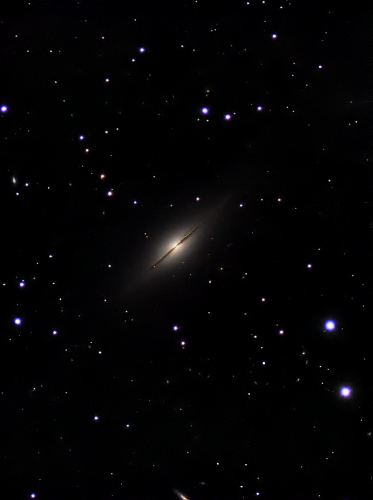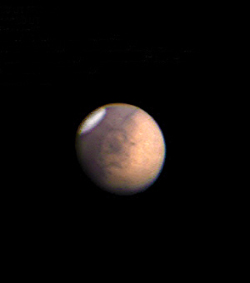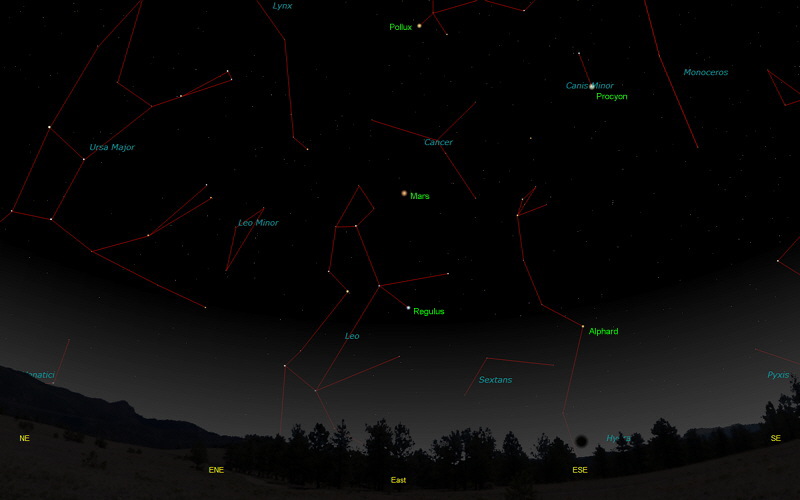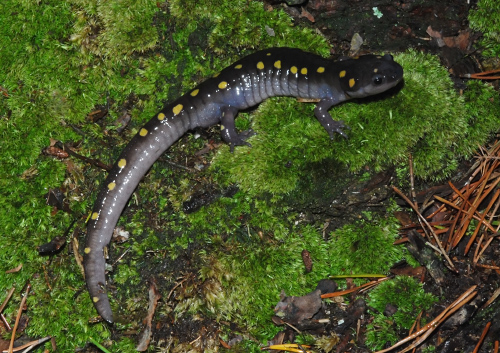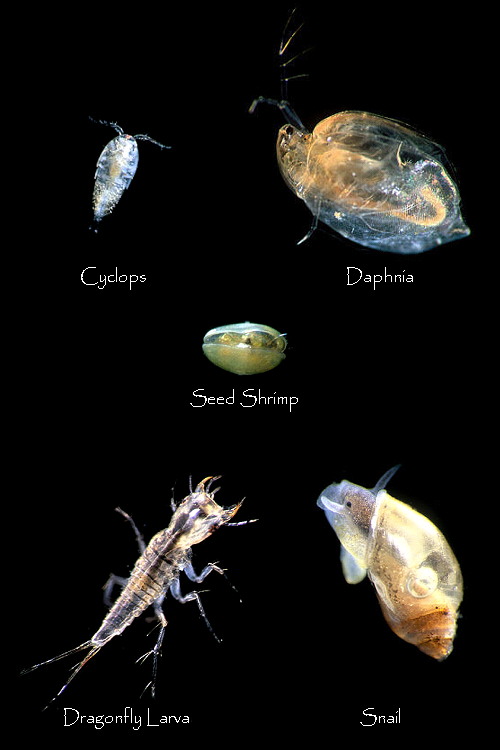The purpose of this feature is to give scout leaders, educators and naturalists an idea of some of the natural events coming up each month. We will try to cover a variety of natural events ranging from sky events to calling periods of amphibians, bird and mammal watching tips, prominent wildflowers and anything else that comes to mind. We will also note prominent constellations appearing over the eastern horizon at mid-evening each month for our area for those who would like to learn the constellations. If you have suggestions for other types of natural information you would like to see added to this calendar, let us know! Note: You can click on the hyperlinks to learn more about some of the featured items. To return to the Calendar, hit the "back" button on your browser, NOT the "back" button on the web page. All charts are available in a "printer friendly" mode, with black stars on a white background. Left clicking on each chart will take you to a printable black and white image. Please note that images on these pages are meant to be displayed at 100%. If your browser zooms into a higher magnification than that, the images may lose quality. Though we link book references to nationwide sources, we encourage you to support your local book store whenever possible.
Notes and Images From December 2009
I don't remember when I first visually tracked down the ghostly edge-on galaxy NGC 7814. But since it is near Algenib, one of the corner stars of the "square of Pegasus," it's not too hard to find. Over the years I've seen it several times in a variety of telescopes. It's surface brightness is pretty low, and although small telescopes will show the brighter nucleus, observing the very thin dust lane that cuts through the nucleus takes a larger scope. I've seen the dust lane well in a 20" diameter Newtonian telescope. Like NGC 891, an edge-on galaxy in Andromeda, NGC 7814 always leaves you wishing you had a bigger telescope. Far beyond visual range are the very faint and small galaxies in the background of the image at right. Clicking on the image will take you to a larger high-resolution image where you can better see these very faint galaxies. There is a more or less horizontal line of galaxies about 1/4 of the way from the bottom of the image to the top. NGC 7814 is around 49,000,000 light-years away. The faint background galaxies are probably more than a billion light-years away.
Sky Events for January 2010: Earth reaches perihelion, the point in its orbit closest to the Sun, on January 3rd. It is then only 91,402,485 miles from the Sun. Although the shortest day of the year is on the winter solstice in December, the latest sunrise of the year for our latitude does not occur until January 6th. The earliest sunset occurs about 2 weeks before the solstice. Evening Sky: At the beginning of the month, Jupiter is about 25 degrees above the southwestern horizon at dusk. By the end of the month it will sink into the twilight glow.
Mars rises about 7:30pm CST in Leo at the beginning of the month. The red planet glows quite brightly now, and outshines all stars in the night sky except Sirius. Mars will be closest to the Earth on January 29th, as the two planets approach each other to within 61.7 million miles. This is a fairly distant opposition of Mars. During the record-setting close opposition of August, 2003, Mars and Earth approached to within 35 million miles. We took the image at right on July 20th, 2003, when Mars was about 43 million miles from Earth. The dark spot left of the center of the planet is Solis Lacus, the Lake of the Sun. Most of the current names of Martian surface features are based on a map created by the Italian astronomer Schiaparelli in 1877. The name Solis Lacus was chosen because Schiaparelli thought the "lake" and surroundings looked like the ancient symbol for the Sun, ¤. He named many Martian surface features after geographical and mythical names found on ancient maps of the Earth. You can learn a lot about mythology and ancient cartography on Earth by looking up the meanings of the Martian names. If you can still find it, a wonderful book for this is Mars and its Satellites, A Detailed Commentary on the Nomenclature, by Jurgen Blunck. The etymology of all Martian surface feature names, and the associated legends, are traced in this book. A new nomenclature, which retains at least parts of many of the old names, was established after the Mariner 9 space probe completed its mission. Solis Lacus, for instance, is Solis Planum in the new nomenclature. In the image above, just below Solis Lacus is the dark swath that marks Valles Marineris, a canyon over 2,500 miles in length and up to 20,000 feet deep. The south polar cap is prominent. The 2003 opposition was the closest opposition of Mars in recorded history. We were able to spot Deimos and Phobos, the two tiny moons of Mars, for the first time. Most of the time we had our dog Bailey at our side while we were observing. If you view Mars in a telescope, be prepared to view a very small, very bright disk with extremely low-contrast markings. You must be patient and wait for moments when the atmosphere is steady to glimpse the famous (or infamous in the case of the "canals") darker areas. Naked eye observers might want to compare Mars to bright stars nearby. Planets generally twinkle less than stars at the same altitude above the horizon. Sky and Telescope has a "Mars Profiler" online that shows which face of Mars is facing Earth at any given time. This can be very helpful, and you may want to choose a time to observe when a darker area like Syrtis Major is in the center of the disk. When asked for the time in Universal Time (UT), add 6 hours to Central Standard Time in 24 hour format. For instance, 5:00pm CST on January 1st would be 17:00 hours in a 24 hour format. This would equate to 17 + 6 = 23:00 hours UT on January 1st. Note that for later times in the evening the Universal Time will be on the following day. For example,10:00pm on January 1st would be 22:00 hours in a 24 hour format. Adding 6 hours will give you 28:00 hours, or 04:00 hours UT on January 2nd. To go to the Mars Profiler, click here. Saturn rises around 10:20pm CST at mid-month in Virgo. Morning Sky: The Quadrantid Meteor Shower peaks in the morning hours of January 3rd. The peak historically has been brief but can produce good numbers of meteors. This year the Moon will be only a few days past full and will tend to interfere with observations. Look for Mercury in the morning sky about 30 to 40 minutes before sunrise from January 15th through the beginning of February. The planet should be about 10 degrees above the southeastern horizon.
All times noted in the Sky Events are for Franklin, Tennessee and are Central Standard Time. These times should be pretty close anywhere in the mid-state area. Constellations: The views below show the sky looking east at 9:30pm CST on January 15th. The first view shows the sky with the constellation outlines and names depicted. Star and planet names are in green. Constellation names are in blue. The second view shows the same scene without labels. Ursa Major, the Great Bear, has now cleared the horizon in the northeast. The bright stars of Leo, the Lion, are visible now and Hydra, the Water Serpent, rears its head menacingly. Hydra's brightest star Alphard is known as "The Solitary One" because of its somewhat isolated location from other bright stars. Canes Venatici, the Hunting Dogs, also makes its appearance just above the northeast horizon. Among the fainter constellations visible in the east are Leo Minor, the Small Lion, Cancer, the Crab, and Sextans, the Sextant. Outshining all of the stars in the east this month is Mars, glowing brightly as it and the Earth approach each other. They will be closest on January 29th.
On Learning the Constellations: We advise learning a few constellations each month, and then following them through the seasons. Once you associate a particular constellation coming over the eastern horizon at a certain time of year, you may start thinking about it like an old friend, looking forward to its arrival each season. The stars in the evening scene above, for instance, will always be in the same place relative to the horizon at the same time and date each January. Of course, planets like Mars do move slowly through the constellations, but with practice you will learn to identify them from their appearance. In particular, learn the brightest stars (like Regulus and Procyon in the scene looking east), for they will guide you to the fainter stars. Once you can locate the more prominent constellations, you can "branch out" to other constellations around them. It may take you a little while to get a sense of scale, to translate what you see on the computer screen or what you see on the page of a book to what you see in the sky. Look for patterns, like the stars of Leo. The earth's rotation causes the constellations to appear to move across the sky just as the sun and the moon appear to do. If you go outside earlier than the time shown on the charts, the constellations will be lower to the eastern horizon. If you observe later, they will have climbed higher. As each season progresses, the earth's motion around the sun causes the constellations to appear a little farther towards the west each night for any given time of night. If you want to see where the constellations in the above figures will be on February 15th at 9:30pm CST, you can stay up till 11:30pm CST on the January 15th and get a preview. The westward motion of the constellations is equivalent to two hours per month. For instance, if you want to see what stars will be on your eastern horizon on April 15th at 9:30pm CST (3 months later), you would need to get up at 3:30am CST in the morning on January 15th (3 months times 2 hours/month = 6 hours). Recommended: Sky & Telescope's Pocket Star Atlas is beautiful, compact star atlas. It is destined to become a classic, and is a joy to use at the telescope. A good book to learn the constellations is Patterns in the Sky, by Hewitt-White. You may also want to check out at H. A. Rey's classic, The Stars, A New Way to See Them. For skywatching tips, an inexpensive good guide is Secrets of Stargazing, by Becky Ramotowski. A good general reference book on astronomy is the Peterson
Field Guide,
A Field Guide to the Stars and Planets, by Pasachoff. The book retails for around $14.00. Starry Night has several software programs for learning the night sky. Visit the Starry Night web site at www.starrynight.com for details.
Amphibians:
A lot of things happen with amphibians in January. To see them, though, you have to be out in the sort of weather that makes most people stay indoors. The trick is to go out on mild (50 degrees Fahrenheit or warmer) rainy nights. For safety, it is important that you have another person with you to watch for traffic as you slowly drive the back roads, looking for things that cross the road in front of you. Make frequent stops to listen for calling frogs. We have already had Upland Chorus Frogs calling in December of 2009. In January, calling Spring Peepers are not uncommon (they have been observed calling every month in Tennessee), and Wood Frogs have their short-lived breeding choruses in woodland ponds. Southern Leopard Frogs are also sometimes calling on mild January nights. We have seen Northern Cricket Frogs, Green Frogs, American Bullfrogs and American Toads foraging in January. And just about anything is possible. On January 22, 1999, we found a Eastern Spadefoot out in the stormy weather. That same day a tornado ripped through Clarksville, Tennessee, doing much damage to the Austin Peay campus. January is an exciting time of year to look for herps! Recommended: The Frogs and Toads of North America, Lang Elliott, Houghton Mifflin Co.
Winter Pond Life: Although some Tennessee wildlife is in a dormant state during the winter months, many species remain active. Small ponds are a good habitat to check for some of these species. Frogs and toads forage around the edges of ponds on mild winter evenings, and you can see them by placing a flashlight or spotlight beside your temple and slowly scanning the banks. It is important to have the beam of light close to your eyes, as this maximizes the amount of reflected eye-shine that you see. You can also do your scan with a spotlight and binoculars. We have found many frogs and toads in the winter this way. Being familiar with the calls of frogs that breed during the winter is also helpful. Upland Chorus Frogs, Spring Peepers and Wood Frogs all call in January.
Tiger Salamanders and Spotted Salamanders breed during the early winter, and you can sometimes find their egg masses in ponds. Rainy nights are the best time to check for adult salamanders, but you can check for the egg masses anytime. Red-spotted Newts can also be seen with a spotlight in the shallow water near the pond's edge.
Some of the most interesting wildlife to be found in winter ponds occurs on a small scale. Many insects and crustaceans can be found in the water or beneath the ice, and collecting a few water samples and examining them with a hand lens or small microscope will give you a window into their world. Freshwater crustaceans like the Daphnia, Cyclops and Seed Shrimp are common in ponds and pools, as are many types of small snails. Dragonfly larvae will spend the winter as larvae before transforming to their summer adult form. In keeping with our astronomical theme this month, the word larva comes from the Latin word for ghost or specter. Both larval and the adult dragonflies are voracious predators. The larval dragonflies are in turn preyed upon by frogs and newts. With the exception of the dragonfly larva, all of the creatures shown at right are less than three millimeters in length. All came from one small sample of water we took by breaking through the ice covering a small pond near Springfield, Tennessee. After photographing them, we released them back into the pond.
Archives (Remember to use the back button on your browser, NOT the back button on the web page!) Natural Calendar December 2009 Natural Calendar November 2009 Natural Calendar September 2009 Natural Calendar February 2009 Natural Calendar December 2008 Natural Calendar November 2008 Natural Calendar September 2008 Natural Calendar February 2008 Natural Calendar December 2007 Natural Calendar November 2007 Natural Calendar September 2007 Natural Calendar February 2007 Natural Calendar December 2006 Natural Calendar November 2006 Natural Calendar September 2006 Natural Calendar February 2006
Natural Calendar
December 2005
Natural Calendar
November 2005
Natural Calendar
September 2005
Natural Calendar
February 2005
Natural Calendar
December 2004
Natural Calendar
November 2004
Natural Calendar
September 2004
Natural Calendar
February 2004
Natural Calendar
December 2003
Natural Calendar
November 2003
Natural Calendar
September 2003 Natural Calendar February 2003 Natural Calendar December 2002 Natural Calendar November 2002 Nature Notes Archives: Nature Notes was a page we published in 2001 and 2002 containing our observations about everything from the northern lights display of November 2001 to frog and salamander egg masses.
Night scenes prepared with The Sky Professional from Software Bisque All images and recordings © 2010 Leaps |
||||||||||||
